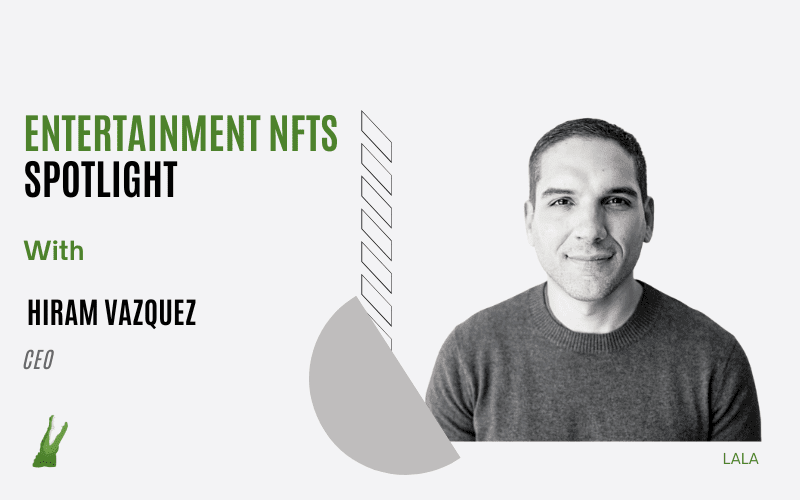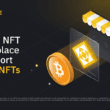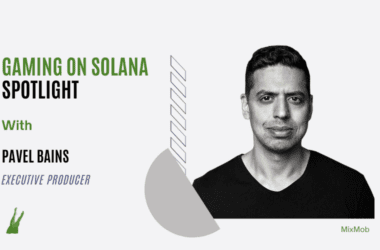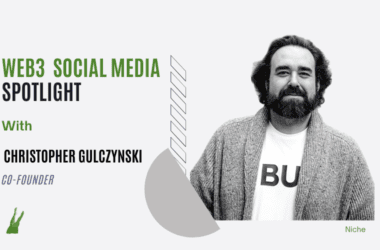Quick take:
- Hiram Vazquez tells us how NFTs can be used to unlock more value in the entertainment industry.
- He also provides his views on the NFT royalty fee debate and where his company stands.
- And tells us how he got Reddit co-founder to invest in LALA.
Although many people still view NFTs as just JPEGs and digitised versions of artwork, the industry has evolved over the past eighteen months to be more than that.
Now, companies are focused on offering products that use NFTs to unlock more utility in real-life experiences, than NFTs for profile pictures.
Leading brands like Starbucks have launched loyalty programs built on the blockchain, illustrating one of the most exciting NFT use cases, while others have explored the use of NFTs in ticketing.
LALA is using NFTs to unlock utility in the entertainment industry. The company recently raised $3 million in a seed round led by Alexis Ohanian’s Seven Seven Six and has already unveiled its first film collaboration with “The Wolf of Wall Street”.
Fans and collectors of the hit 2013 film who hold LALA NFTs will be able to own a portion of the revenue stream.
TV and Film NFTs allow fans to earn a share of the revenue generated from streaming platforms. But they can also be used to reward fans with physical and digital merchandise depending on how many points they collect from streaming their favourite stories.
In December 2021, the NFT project Sneaky Vampire Syndicate partnered with Scream Movies to bring real-world utility to its community. Collectors of the collab NFTs rewarded fans with free movie tickets and early access to the 2022 Scream film.
Last October, Warner Bros teamed up with web3 studio Eluvio to bring “The Lord of the Rings” to web3 with a limited edition NFTs based on the “The Lord of The Rings: The Fellowship of the Ring” film.
In January 2023, digital film collectibles platform Movieplex collaborated with Cinema Libre to launch a full-length NFT film on OpenSea. At the time, Philippe Diaz, Founder and Chairman of Cinema Libre Studios said: “NFTs are the future of film viewing.”
And in our latest Q&A, LALA’s Hiram Vazquez provides a deep dive into the whole idea of NFTs in the film industry and how they can be used to unlock more value in movies and TV.
Please tell us a bit about yourself and the story behind LALA.
As an entrepreneur, my vision is to create a deeper connection between fans and the stories they love by giving them new levels of ownership and access to the movie and TV stories we know and love, all unlocked by blockchain technology.
Growing up in Puerto Rico, I was obsessed with movies, TV shows, and video games because my access to them helped me learn English. However, as I was so geographically far away from Hollywood, most of the promotions, fan contests, or sweepstakes that I would learn about from TV commercials or the back of cereal boxes were exciting for kids in the States, but not eligible for residents of Puerto Rico. Even most of the cool merch from these movies or shows wasn’t available for purchase on the island.
This experience made a strong impression on me, and has fueled my excitement for democratizing access and experiences for fans with LALA, at a time when blockchain technology allows us to do so. This goes hand-in-hand with the growing desire from fans to get more involved with their favorite films and TV shows. The movies subreddit is the 6th largest community on the Reddit platform, with over 31 million members! LALA exists to help fans connect at a deeper level with the IP through ownership and exclusive access. We are looking to disrupt an industry that has long anticipated a need for innovation as it pertains to the fan experience and connecting with the fan community.
What differentiates LALA from other NFT marketplaces?
LALA is more than just a marketplace. Yes – we have a marketplace component, where fans can go and buy digital collectibles (NFTs) that hold a piece of the revenue streams or profits from certain movies but we take it a step further. We are also giving collectors access to limited edition merch of these movies based on the collectible art, a community to connect with fellow holders, both online and offline, and other rewards such as unreleased footage/scenes and even props or other memorabilia from the film – reviving and extending the love for these stories beyond the rolling credits into a vast ecosystem.
What’s your view on the NFT royalty fee saga?
I’ve been following this debate from the sidelines for some time. In short, one of the revolutionary value propositions of blockchain technology is for creators to monetize their work every time someone resells it. That’s what attracted so many artists to it and made the leading marketplaces reach the popularity they have today. As a fan of a lot of these digital artists, I feel for them and disagree with marketplaces circumventing set royalties that are jeopardizing many people’s livelihood. I also question the sustainability of this zero-royalty model long term because that is how some of these marketplaces make most of their revenue.
That said, as a founder my duty is to prepare for the worst case scenario and I’ve been able to readjust my expectations of the projected revenue from secondary sales. We will keep our eyes open to what happens, will advocate for artists (we want to work with the best artists ourselves and promote them on our platform!) and hope the community as a whole can find a sustainable solution that works for everyone.
Do you see LALA offering more than entertainment (Movie and TV shows) NFTs in the future?
Right now we are very focused on delivering an easy and approachable fan experience at LALA, offering connections to IP from movies and TV shows. In the future, if there’s demand from our community, we may consider exploring additional offerings in the larger entertainment space.
How did you get the Reddit co-founder’s venture fund to lead your seed round?
I worked closely with Alexis Ohanian as an operating partner at his venture capital firm, Seven Seven Six, and we are both REALLY into collectibles. Alexis has been part of the LALA journey from the get-go, as we started brainstorming together about blockchain utility and use cases for it in more traditional industries. His firm leading our funding cements his belief in the LALA vision for a new fan experience.
How has crypto winter affected NFT funding? Is it harder now to get venture capital firms to invest?
During this crypto winter, there are still plenty of opportunities for startups to build on top of blockchain technology and NFTs. Yes, there is less speculation and, overall, fewer sky-high valuations that aren’t defensible (i.e. startups in the space will have to look more like traditional startups than just hyped pfp projects to get VC attention). This, I believe, is good for the long-term health of the space and people, including ourselves, will have to build real businesses to attract future investors.
There is still a lot of opportunity and we are getting a lot of inbound leads from investors looking to invest in the space. That validates our view that we are going to see a second wave of NFT companies, such as LALA, that will focus less on the tech jargon and more on solving a very real problem or creating an incredible customer experience with the help of blockchain technology. This approach helped us secure our recent $3 million funding led by Alexis Ohanian’s venture capital fund Seven Seven Six, who also share this view of the space.
What do you think are the main obstacles to the mainstream adoption of NFTs?
NFTs have a lot of areas for opportunity, it’s still really early in the space. Currently the tools and capabilities for customer experience related to NFTs are being built but the reality is that it’s intimidating to most people to get onboarded. The quicker we provide both the tools to simplify with new and interesting use cases, people will start signing up. There are some opportunities we can start adopting today:
- Stigma around NFTs- unfortunately the NFT space is experiencing a perception problem. A lot of people think all NFTs are scams because of the bad actors in the space, and in crypto in general. In reality, there are a lot of people and companies, even Fortune 500 ones such as Nike and Starbucks, that are investing heavily in building products and experiences around these. This is evidence of the potential for NFTs.
- Too much tech jargon – with the NFT industry still in its infancy, we are introducing a new language that many find unapproachable. The industry needs to focus on simplifying the language used around NFT’s and focus on the problems they solve, making them more relatable to a mass audience.
If we do all these things, then we’ll unlock the real use cases where people will finally own digital assets that are tied to real experiences and perks.
Imagine hardcore Star Wars fans that have owned a real-size R2-D2 sculpture for decades, all the movies, signed memorabilia from the cast, etc. Now imagine if Disney (now owner of Star Wars) could very easily get that information when they are getting ready to open a new Star Wars theme park experience. With digital assets, Disney now can see that a superfan owns 50 of the most valuable Star Wars digital collectibles and have participated in a number of limited physical merch drops only available for purchase to the owners of some of those very rare NFTs. And they can trust that the data is real because it is verified by the blockchain. Imagine how valuable would that be for Disney, or even another studio releasing a project that targets a similar demographic to Star Wars?
Where do you see the NFT industry in five years? Will it still be a major vertical in crypto?
New companies to the space are not going to focus so much on the tech behind NFTs. There are going to be a wide variety of consumer companies that are using NFTs for various purposes like loyalty programs and gaming, but the focus is on a superior customer experience to what’s possible today in each of those spaces. This is how we are approaching it with LALA and proof of that starts with calling them digital collectibles. NFTs are a great tool to unlock this ownership and new access layers — but we’re not focusing on the tech jargon that might alienate people from even trying to use these. Similar to how the average consumer doesn’t speak about HTML, we just talk about websites that solve a problem and/or provide an incredible customer experience.
Anything else related to current events in the world of NFTs you want to add?
Similar to the previous question, the focus is shifting from the novelty aspects of NFTs to using them to solve real-life problems for people. Also, early adopters are realizing that this is how web3 goes mainstream, by leveraging its potential and doing something with it. This is what we’re doing with the new fan ownership and experiences being created at LALA.
****
Stay up to date:
Subscribe to our newsletter using this link – we won’t spam!





